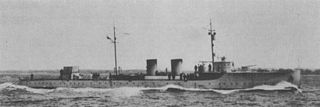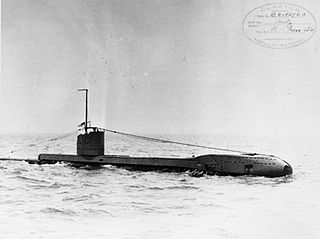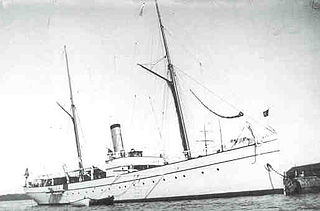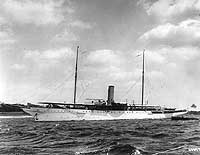
HMS Argonaut (F56) was a Leander-class frigate that served with the Royal Navy from 1967 to 1993. She took part in the Falklands War in 1982, sustaining damage and casualties in action.

USS Winchester (SP-156) was an armed yacht that served in the United States Navy as a patrol vessel from 1917 to 1919. Prior to and following World War I, Winchester was a private yacht, later renamed Renard. In World War II, Renard was requisitioned for use in the Royal Canadian Navy as a patrol vessel, keeping her name. She was returned to her owners in 1944.

HMS Unity was a U-class submarine, of the first group of that class constructed for the Royal Navy. The submarine entered service in 1938 and performed war patrols during the Second World War. On 29 April 1940, Unity was accidentally rammed and sunk in Blyth, Northumberland's harbour.

HNoMS Heimdal was a Norwegian warship built at Akers mekaniske verksted in Kristiania, Norway in 1892 with build number 137.

HMCS Ambler was an armed yacht that was acquired by the Royal Canadian Navy during the Second World War as a patrol and training vessel. Constructed in 1922, Ambler was under private ownership until 1940 when the vessel was requisitioned for service in the Royal Canadian Navy. Initially used as a patrol vessel, Ambler was used as a training vessel until 1945. Following the war, Ambler was sold to private interests.

HMCS Beaver was an armed yacht that served in the Royal Canadian Navy during the Second World War. Originally named Aztec, the yacht was requisitioned for service in the United States Navy during the First World War under the same name. Returned to her owner in 1919, the yacht was laid up in 1931 following her owner's death. The vessel was purchased via a third party for service in the Royal Canadian Navy and after commissioning, Beaver was primarily used as a training ship with limited time as a patrol vessel. Following the war she was sold in 1946 and broken up for scrap in 1956.

Naval trawlers are vessels built along the lines of a fishing trawler but fitted out for naval purposes; they were widely used during the First and Second World Wars. Some, known in the Royal Navy as "Admiralty trawlers", were purpose-built to naval specifications; others were adapted from civilian use. Fishing trawlers were particularly suited for many naval requirements because they were robust vessels designed to work heavy trawls in all types of weather, and had large clear working decks. A minesweeper could be created by replacing the trawl with a mine sweep. Adding depth charge racks on the deck, ASDIC sonar below, and a 3-inch (76 mm) or 4-inch (102 mm) gun in the bow equipped the trawler for anti-submarine duties.

An armed yacht was a yacht that was armed with weapons and was typically in the service of a navy. The word "yacht" was originally applied to small, fast and agile naval vessels suited to piracy and to employment by navies and coast guards against smugglers and pirates. Vessels of this type were adapted to racing by wealthy owners. The origin of civilian yachts as naval vessels, with their speed and maneuverability, made them useful for adaptation to their original function as patrol vessels. In the United States Navy armed yachts were typically private yachts expropriated for government use in times of war. Armed yachts served as patrol vessels during the Spanish–American War and the World Wars. In the latter conflicts, armed yachts were used as patrol vessels, convoy escorts, and in anti-submarine duties. In the United States, yachts were purchased from their owners with the owners given an option to repurchase their yacht at the close of hostilities.

HMCS Raccoon was an armed yacht that served in the Royal Canadian Navy during World War II. Purchased by the Royal Canadian Navy in 1940, the ship was originally known as the yacht Halonia. Used as a patrol vessel and convoy escort, the ship was sunk by the German submarine U-165 in the St. Lawrence River on 7 September 1942. Raccoon was escorting Convoy QS-33 at the time. The entire ship's crew was lost.

Dieppe was a steam passenger ferry that was built in 1905 for the London, Brighton and South Coast Railway. She was requisitioned during the First World War for use as a troopship and later as a hospital ship HMS Dieppe, returning to her owners postwar. She passed to the Southern Railway on 1 January 1923. In 1933 she was sold to W E Guinness and converted to a private diesel yacht, Rosaura. She was requisitioned in the Second World War for use as an armed boarding vessel, HMS Rosaura. She struck a mine and sank off Tobruk, Libya on 18 March 1941.

HMS Warrior was a steel-hulled steam yacht that was launched in Scotland in 1904. Her first owner was Frederick William Vanderbilt. One of his cousins, Alfred Gwynne Vanderbilt, owned her for a few months before he was killed in the sinking of RMS Lusitania. She passed through several owners. She was renamed Wayfarer in 1914, Warrior again in 1915, Goizeko-Izarra in 1920, Warrior again in 1937, and Warrior II in 1939. She was commissioned into the Royal Navy in both world wars, and evacuated Republican child refugees in the Spanish Civil War.

Grille was an aviso built in Nazi Germany for the Kriegsmarine in the mid-1930s for use as a state yacht by Adolf Hitler and other leading individuals in the Nazi regime. The ship received a light armament of three 12.7-centimeter (5 in) guns and was fitted to be capable of serving as an auxiliary minelayer. Completed in 1935, her experimental high-pressure steam turbines, which were installed to test them before they were used in destroyers, required significant modifications and the ship finally entered service in 1937. Over the next two years, she was used in a variety of roles, including as a training vessel and a target ship, in addition to her duties as a yacht.

HMS Wolsey (D98) was a W-class destroyer of the British Royal Navy that saw service in the final months of World War I, in the Nanking incident of 1927, and in World War II.
HMS Lorna was a British armed yacht which served in the Royal Navy. Originally built in 1904 as a luxury steam yacht, she served in both the First and Second World Wars and destroyed a German U-boat in 1918. After the war, she became a passenger vessel in Greece, but sank in 1966 and was scrapped two years later.
This page is based on this
Wikipedia article Text is available under the
CC BY-SA 4.0 license; additional terms may apply.
Images, videos and audio are available under their respective licenses.












